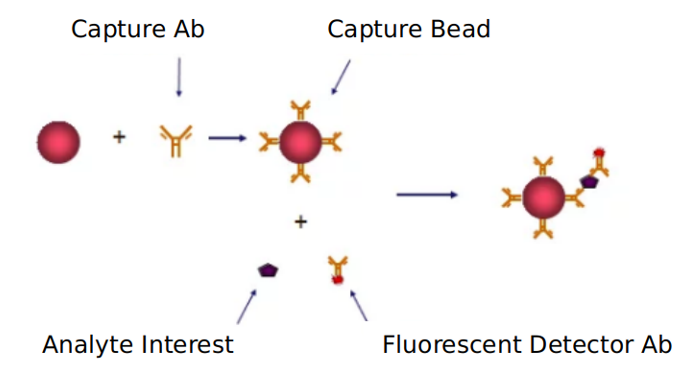Death receptor signaling pathway
Based on Luminex technology platform, Creative Proteomics provides analysis services for key targets of death receptor signaling pathway.
Death receptors are cell surface receptors that can transmit apoptosis signals triggered by specific ligands and play a central role in guiding apoptosis. Death receptors include a variety of molecules. The research on death receptors and their ligands is one of the hotspots in the current research on apoptosis.
Death receptors belong to the tumor necrosis factor receptor (TNFR) gene superfamily. To date, eight members of the death receptor family have been characterized: TNFR1 (also known as DR1, CD120a, p55 and p60), CD95 (also known as DR2, APO-1 and Fas), DR3 (also known as APO- 3. LARD, TRAMP and WSL1), TRAILR1 (also known as DR4 and APO-2), TRAILR2 (also known as DR5, KILLER and TRICK2), DR6, ectodysplasin A receptor (EDAR) and nerve growth factor receptor (NGFR) ). These death receptors are characterized by a cytoplasmic region of approximately 80 residues called the death domain (DD). When these receptors are triggered by the corresponding ligands, many molecules are recruited to the death domain, and then the signal cascade is activated. Two types of death receptor signaling complexes can be distinguished. The first group includes the death-inducing signaling complex (DISC) that causes caspase-8 activation, the latter playing a central role in the transduction of apoptosis signals. DISC is formed at the CD95 receptor, TRAILR1 or TRAILR2. The second group includes TNFR1, DR3, DR6 and EDAR. These recruit a different set of molecules that simultaneously transduce apoptosis and survival signals.

Death receptor ligands initiate signal transduction through receptor oligomerization, which leads to the recruitment of specific adaptor proteins and the activation of the caspase cascade. The binding of FasL induces the trimerization of Fas, thereby recruiting priming caspase-8 through the adaptor protein FADD. Then, caspase-8 is oligomerized and activated by autocatalysis. Activated caspase-8 can induce apoptosis through two parallel cascades: it can either directly cleave and activate caspase-3, or cleave the pro-apoptotic protein Bid of the Bcl-2 family. The truncated Bid (tBid) translocates into the mitochondria and induces the release of cytochrome C, thereby activating caspase-9 and -3. TNF-α and DR-3L can transmit pro-apoptotic or anti-apoptotic signals. TNFαR and DR3 promote cell apoptosis through the adaptor protein TRADD/FADD and activation of caspase-8. The interaction between TNF-α and TNFαR can activate the NF-κB pathway through NIK/IKK. The activation of NF-κB induces the expression of pro-survival genes, including Bcl-2 and FLIP, the latter can directly inhibit the activation of caspase-8. FasL and TNF-α can also activate JNK through ASK1/MKK7. Activation of JNK inhibits Bcl-2 through phosphorylation. In the absence of caspase activation, the stimulation of death receptors can lead to the activation of another programmed cell death pathway through the formation of complex IIb, which is called necroptosis.
Our detectable targets:
| MKK1 | Daxx | FADD | TRADD | TRAF1 | TRAF2 |
| RIP | Casp-8 | JNK | Casp-10 | CYLD | clAP1 |
| clAP2 | BID | tBID | Bcl-2 | MKK1 | Casp-9 |
| XIAP | Casp-6 | Casp-3 | NFκB | Casp-7 | TRAF1 |
| GAS | IRF9 | Smac | IkB | RelB | TRAF2 |
| Lamin A | Actin | GAS2 | ROCK1 | DFF45 | TRAF3 |
| IKK-α | Acinus | PARP | p52 | Cyto c | Apaf1 |
| IKK-β | DFF40 | NIK | p65 |
Technology platform
We provide Luminex technology for death receptor signaling pathway analysis.
Luminex technology is a multifunctional liquid phase analysis platform developed on the basis of colored microspheres, laser technology, applied fluidics and high-speed digital signal processing technology. The core is to encode polypropylene microspheres or magnetic microspheres with fluorescent dyes. By adjusting the different ratios of the two fluorescent dyes, up to 100 microspheres with different fluorescence spectra can be obtained. Each kind of microspheres is covalently cross-linked. Capture antibodies against specific antigens.
Death receptors include a variety of molecules and are cell surface receptors that can transmit apoptosis signals triggered by specific ligands and play a central role in guiding apoptosis.
In addition to Luminex Multiplex Assay, Enzyme-linked immunosorbent assay (ELISA), Flow cytometry (FACS analysis) technology can also be provided to meet other customer needs.
Advantages of death receptor signaling pathway detection:
- High flexibility: specific probes, antigens or antibodies can be connected to the microspheres to meet the needs of different customers.
- Good repeatability: similar homogeneous reaction mode, each indicator has 1000-5000 reaction units, and the median value of 100 analysis is taken.

Application of our service:
- To study the effect of each virus on death receptor signaling pathway
- To study the regulation mechanism of death receptor signal pathway in disease
- To study the effects of drugs or therapies on death receptor signaling pathways
Creative Proteomics has developed a signal pathway target detection platform. We are not limited to providing death receptor signal path detection services, but can also provide other signal path detection services. If you want to detect other targets, please contact us and we will customize the service for you. Look forward to working with you.
References:
- Declercq W, Vanden Berghe T, et al. RIP kinases at the crossroads of cell death and survival. Cell, 2009, 138(2): 229–32.
- Fuchs Y, Steller H. Programmed cell death in animal development and disease. Cell, 2011, 147(4): 742–58.
- Kaufmann T, Strasser A, et al. Fas death receptor signalling: roles of Bid and XIAP. Cell Death Differ, 2012, 19(1): 42–50.



